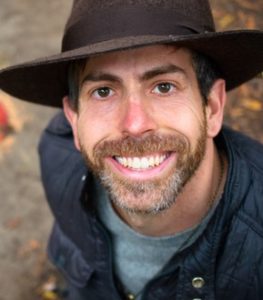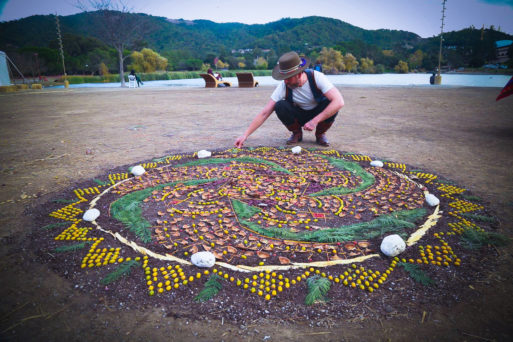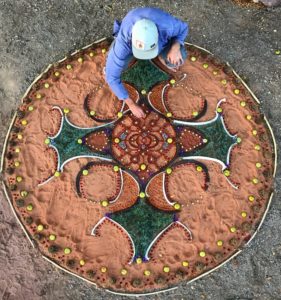In this first part of a two part interview, I sit down with artist and educator, Day Schildkret, best known for his Morning Altars — beautiful pieces of impermanent earth art made as a practice of meditation, wonder and ritual. We recently highlighted a few of his altars in this Soulful Expressions article.
Day is based in Richmond, California, but travels often to create impermanent earth art installations and teach workshops on this daily ritual of beauty-making. I was able to attend one such workshop as part of this year’s ReImagine Death Festival.
Editor’s note: This interview has been edited for length and clarity.

Image Credit:
Morningaltars.com
Colleen Ferguson: How did you begin making Morning Altars?
Day Schildkret: It originated as daily practice when I was in the midst of grieving. About five years ago, I had a tremendous breakup in my life – only two years after my dad had died – and it was the kind of breakup that just wrecked me. None of my practices were appealing – I didn’t want to meditate, I didn’t want to do yoga, I didn’t even want to write. My only responsibility was to walk my dog everyday.
And so I just took her on walks, and since I was grieving my whole energy was about looking down. Because of where I lived I saw all these beautiful things – leaves, pine cones, berries. One early morning — I remember it, we were up in the hills of Wildcat Canyon, and the fog was rolling in — I found this cluster of amber-colored mushrooms that were under a eucalyptus tree. They were beautiful, and I just sat down and began to arrange them.
Colleen: Did you already have an idea of what you wanted to make?
Day: No, not at all. I wasn’t doing it because I had an idea of what I wanted to do, but as a way to deal with my grief. I just wanted to be out of my head for a minute and in my hands. So, I took some eucalyptus bark and caps and these mushrooms, and I just let my imagination go and let it direct me. And for the next couple of hours I channeled my grief through my hands. I was doing, as Martín Prechtel says, metabolizing it into a gift of beauty. I was making beauty from my grief and loss.
And when I finished that piece I immediately felt lighter. Something had been processed. So I asked myself – can I do this for 30 more days? And I did.
Colleen: How did you start teaching this practice to others?
Day: Well, for a long time, the daily practice of Morning Altars was very personal — it was just something I wanted to share with my friends. So I would take photos and share them with my friends via text. But the response I received was unusually powerful.
My friends were sending back haikus and poetry, or they were going out and making their own. And they encouraged me to continue, so I did. Eventually I began posting my photos on social media, and I received the same response, but this time it was from people I didn’t know – people from Poland, Australia, Iran, Peru, and beyond — people who were inspired to go out where they lived and make their own. And they were sending me their pieces and I was sending them mine, and we were connecting around the world through altar-making and ritual.

Image Credit: Morningaltars.com
And that’s very much what is still happening. This is a movement we’re looking for, one that I hope will redeem the practice. Humans have been making impermanent earth art for thousands and thousands of years, and it has served so many cultures in grieving, in celebrating, in praying, in community gathering. It served the culture and it served the people. So what I’m hoping to do is redeem that resource for Western culture.
Colleen: The resource of ritual and beauty-making?

Image Credit:
MorningAltars.com
Day: Yes. Many people feel like they have a lack of resources about how to respond to the memory of their loved ones. Creativity — in particular impermanent earth art — is a great resource because it’s mindful. It’s a meaningful creative mediation, and you can wander, really consider your loved one, and make beauty for them. Beauty that is unique to that moment, to that consideration, to that feeling. And you don’t have to be an artist to do it. Anyone can do it.
Colleen: Yes, like all of us here today. Could you speak to why beauty-making and ritual is beneficial as a daily practice?
The practice of creating earth art strengthens our relationship with impermanence and helps us learn to let go of our resistance to change. When we approach the god of death or dying, we often approach it as an amateur, because we have no lived practice being in relationship with change or impermanence. It’s a skill, and we need to practice it everyday to become familiar with it.
I don’t mean practice dying, I mean practice being in a relationship with impermanence. So that when it’s your turn to interact with death, it’s not a monster. For me, I’m interested in the practice. I’m a practitioner-artist-educator. I want to help others by providing them with another resource — like yoga, like mindfulness, like meditation — a practice of being with impermanence.
Join us next week when we continue our interview with Day and talk about the importance of wondering….and wandering.

 How Do You Use Beauty-Making to Process Grief?
How Do You Use Beauty-Making to Process Grief?


 Having an Estate Plan Is Essential – So Is Discussing It With Your Children
Having an Estate Plan Is Essential – So Is Discussing It With Your Children

 “Summons” by Aurora Levins Morales
“Summons” by Aurora Levins Morales














